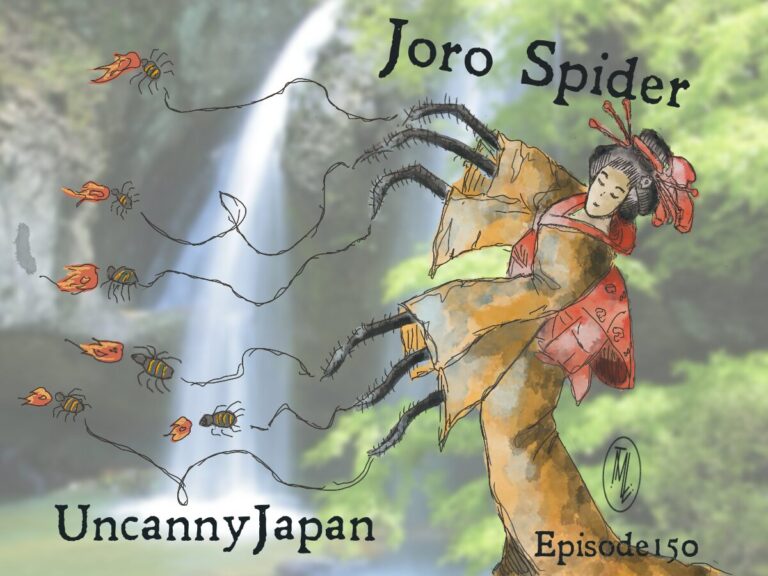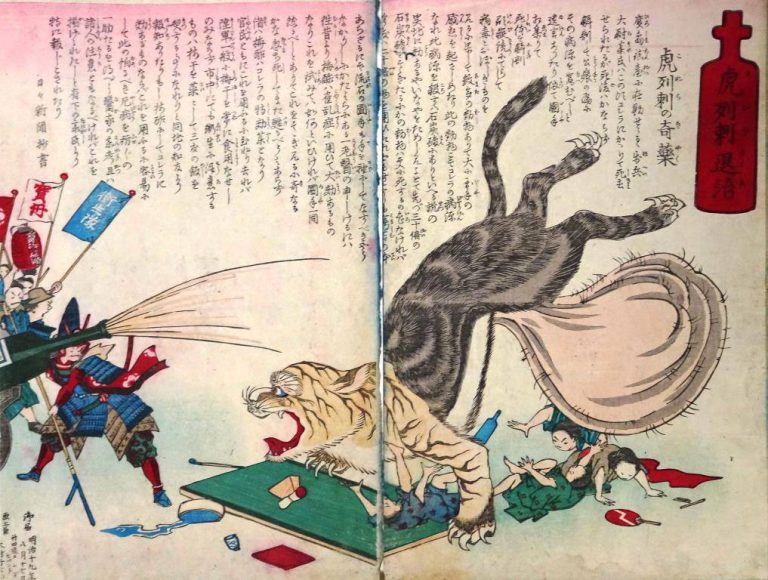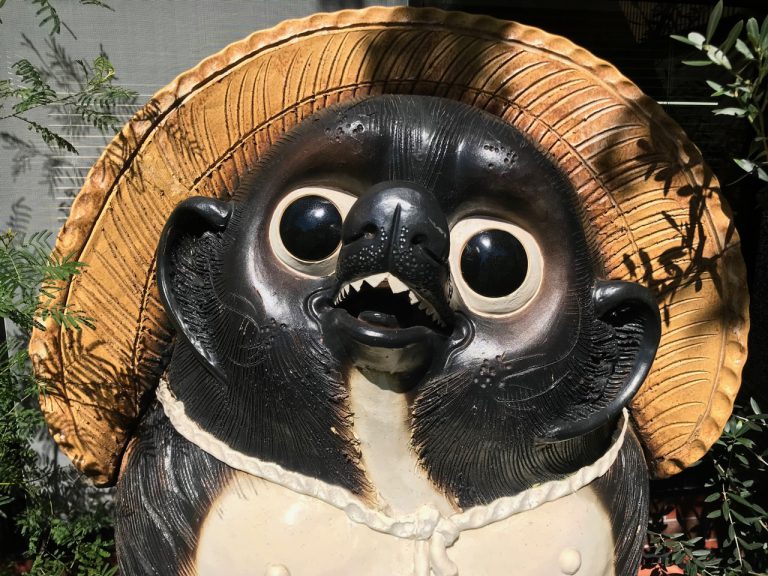Hey hey, this is Thersa Matsuura and you’re listening to Uncanny Japan.
A Tsuchinoko Encounter
Imagine you’re out hiking in the woods of Japan and you hear a strange sound, something like “chii”. Next, you notice some rustling in the bushes up ahead.
What is it? Too small to be a wild boar or a bear. Maybe a baby monkey? Baby tanuki? But before you can even turn around and high tail it out of there, out pops — I mean rolls — a creature that looks like a short, very wide snake. But instead of slithering as snakes are wont to do, it’s got its tail in its mouth and is rolling, end over end, toward you, very quickly.
What the hell? So what is it and what should you do?
Well, I’ll tell you what mysterious creature you’ve just stumbled across and what’s the best course of action, in just a few seconds.
Hang in there a little while longer. Don’t run away just yet. Unless it gets too close then you might want to jump out of the way.
Intro:
News: Nominated for Women’s Podcast Award
Are you still here? Good. A little news: Uncanny Japan got nominated for an International Women’s Podcast Award, the category being Moment of Raw Emotion. The episode right after my father-in-law passed away. I still can’t listen to that.
And Uncanny Robot got a nomination, too. Moment of Dramatic Tension. So I’m very happy about that. Robot got a couple other nominations from different web fests, so I’ll let you know how that turns out.
Today’s episode is one of those spontaneous ones brought to you by a silly and enlightening conversation we just had over on the Uncanny Japan Discord a short while ago (I’ll put the Discord link in the transcripts, by the way, if you’re interested). Anyway, I’ll tell you more about the details of that conversation in a few minutes, because Sam was the one who discovered the last bit of delightful and wild information and I want to give him full credit for that.
What does Tsuchinoko Mean?
But first, what is this thing that you’ve just uncovered? Well, it’s a mysterious, mythical (?) creature that can be seen and heard all over Japan since ancient times — it was even mentioned in the Kojiki (700s), but, yet, not one (again ?) has ever been captured.
It’s called a tsuchinoko 槌の子. I’ve known about them for a long time, and I always assumed the name meant child of the dirt. I mean, it is a snake-like beastie, so that made sense. But I’d never ever seen the kanji until I started writing this. I’d only seen the word written in katakana, the phonetic alphabet usually for foreign words and doesn’t give any clue to the meaning behind the term.
I was surprised to learn tsuchi/槌 means mallet or hammer. Child of the mallet. That changes everything. The reason isn’t because they hit you or anything like that, but because their body-shape resembles an old fashioned hammer or mallet, called a tsuchi, or more precisely a yokotsuchi and, yeah, it does kind of look like the mythical animal. A yokotsuchi has a short little handle which would be the tsuchinoko’s wee little tail. Then it has a thick round part that is used for threshing rice or beating fabric. That would be the tsuchinoko’s wide body.
More Names
But these little fellows aren’t just known as tsuchinoko. There are around forty different names depending on where you live in Japan. Some of their adorable monikers are bachihebi, nozuchi, tsuchimbo, and my favorite tatekurikaeshi which literally means stand up and turn around. If you recall that hair raising intro, that was exactly what that creature was doing.
In folklore the tatekurikaeshi’s main objective in life is to just frighten you and watch you fall down. But since, like a wild boar, it can’t change its direction quickly, you can just wait until the last minute and jump out of the way. There isn’t a lot written about tatekurikaeshi. So that might very well be a very local myth.
Tsuchinoko, however, are all over the place. And by all over the place, I mean they are lurking in the bushes and underbrush in the forests and mountains all over Japan, except Hokkaido and some smaller islands.
Observations about Tsuchinoko
Here is a short list of observations about the tsuchinoko from people who have purported to have encountered one:
1. They are basically shortened, very wide in the middle snake-looking animals that are roughly the size of a loaf of french bread or a bottle of beer and weight about five kilos, a little over ten pounds
2. They have eyelids, where snakes don’t.
3. Boy, can they jump. There are differing reports, but something like they can leap into the air five meters, while springing forward two meters.
4. They enjoy Japanese sake.
5. Their cry or call sounds like “chi-!”
6. Females have spaces between their teeth.
7. They’re incredibly fast.
8. They have different ways of getting around. For example, other than making a big circle and rolling at you they can slither like a snake, crawl forward like an inchworm, and roll sideways like a short fat log.
9. Also, they snore.
10. They favor the scent of miso, dried squid, and burning hair. Who burns hair?
11. Some say they’re extremely poisonous.
12. Some say they talk.
Tsuchinoko Fad
Remember in episode 30 when I talked about the Jinmengyo or Human-Faced Carp? I mentioned that in the 1990s a tabloid published a photo of a alleged jinmengyo and that caused quite the sensation. The same thing happened again with Kuchisake Onna, the slit-mouthed woman (episode 23) in the late 1970s a newspaper got ahold of a story about one being spotted and the whole country went nuts.
Well, that same thing happened with our dear tsuchinoko, too. In 1972 the author Seiko Tanabe wrote a serialized novel in the Asahi Newspaper called Subete Koronda. It followed a protagonist who was crazy about tsuchinoko. A year later the story was turned into an NHK drama. Then in 1973, a manga artist, Takao Yaguchi, wrote Phantom Monster Bachihebi, remember bachihebi is another name for the tsuchinoko. The year after that, in 1974, the darling character Doraemon even came out with an episode about finding one. So that’s three years of serious tsuchinoko attention and it set off the tsuchinoko fad. People began searching for them everywhere.
But What Are They?
One theory is they are a type of blue-eyed lizard in the wild. It seems that it was early in the 1970s that these lizards were first imported into Japan, too. Okay, makes sense, but lizards have legs, don’t move like an inchworm, roll end over end or roll like a log. So…
Now before we get too excited, these little beasties are believed to be cryptids or UMA, Unidentified Mysterious Animals. While there are drawings, painting, replicas, and even suspicious mummified remains of the ugly creatures, there aren’t any living ones anywhere that we can observe. You hear reports about people who have seen them, but no captures.
Despite that, you might have heard of the stout snakes because they make appearances in Pokemon, Yugioh, Metal Gear Solid, Yokai Watch, and Monster Hunter, to name a few.
Which brings me to the fun part and the reason I felt compelled to slip this little chubby creeper episode into my usual lineup.
Our Talk on Discord
Awhile ago I was talking about some urban legend yokai or other when listener and patron, Andrew (who makes some gorgeous hand thrown pottery, by the way at Instagram: @ALRusticWare, link in show notes), anyway, Andrew put up an image of the tsuchinoko and said what I was talking about reminded him of that. Several of us started talking about that for a bit.
Then not relating to tsuchinoko at all, listener, Discord member, and an amazing artist Sam Kalensky (he creates great yokai stickers, also, link in show notes), anyway, Sam pops on after he’d made a Snipe sticker and asked it there was anything in Japan similar to the Hunting of the Snipe. I couldn’t think of anything off the top of my head, neither could anyone else. Cue a little while after than and Sam comes back with news that a friend had actually found the Japanese equivalent of Snipe Hunting and it was *drumroll* the tsuchinoko hunt. It’s really a thing.
Hunting for Tsuchinoko
I searched around, and the two prefectures I saw mentioned most were Gifu and Niigata. In Niigata it’s called Tsuchinoko Tanken/槌の子探検 and in Gifu, Tsuchinoko Festa/槌の子フェスタ. Both events are held in May. Why May? Not exactly sure, but one reason I read was that the tsuchinoko hibernates and wakes up around then. They’re active, hungry, and looking for some romance. So if you’re lucky — not that kind of lucky, perv — if you’re the other kind of lucky, it’s the best time to spot one.
So what happens at a Tsuchinoko Hunt? Basically, it’s a big group of people who all gather to hike around with long-handled nets and cameras around their necks to scour certain mountains and forests looking for the elusive critters. In Niigata, this has been going on since 2006. And every year after the search both the Tsuchinoko Tanken and the Tsuchinoko Festa groups announce that sadly this year, too, they did not manage to spot or catch one of the slippery serpents.
I mean, that all sounds fun enough, but these tsuchinoko lovers make their quest all the more enjoyable, for example, in Niigata they even have a theme song called The Tsuchinoko Sanba. Nice, huh?
So while I used to think them creepy and gross, after more consideration, I’ve decided they are super cute. I mean, there’s their shape, and then you have the adorable mascots, and cookies, mochi, amulets, keychains, stuffed animals…you name it. All of the goods are very kawaii.
But is kawaii enough to get you trekking through the bramble all day long? Because remember, they might be poisonous, too. Maybe not, but you know what would get me out there? A reward.
Yes, reward. Now this has been around for as long as I can remember. But I just realized the rewards are different for different prefectures and areas. But in general, if you nab yourself a real live tsuchinoko you can receive around one million yen, more or less, depending. Some places offer smaller rewards for even a good photo. So next time you’re visiting Japan, or if you’re already here, and you’re going to go for a hike, grab that long-handled net and keep your eyes peeled for one of these thicc little buddies.
Okay, I’ll end for today. Thank you Sam for digging up the Tsuchinoko Hunt information and Andrew for reminding me after years about the tsuchinoko. I’ll put links to their awesome goodness in the show notes. And while I’m on the subject of awesome goodness, it’s not Japan related, but another patreon, Amy, has created a gorgeous oracle deck called the 1836 Oracle. She’s a Texas native and I was born there and so feel connected with her work. Her words: “With these 50 cards I have attempted to capture what we love about our home and what we hope to change for future generations. My intention is to serve as both a mirror and a big hug for the folks that feel worn out from riding the waves of hope and despair that come with the territory.” I’ll also put a link to her kickstarter in the transcripts.
Thank you so much for listening. Patrons, I visited the wolf temple-shrine so I’ll put up pictures soon. There’s another one I’m going to visit at the end of the month on my day off, a Fire Shrine. It’s a two hour drive and a two hour hike to the tippy top of a mountain. It’s very old and has an interesting history. I’ll post all that next month when I get it all ready.
Have a wonderful day and I’ll talk to you soon, bye bye.







Thank you so much for the shout outs & another wonderful episode Teresa!! – In turn, I also want to extend the shoutout to my friends (that helped me confirm the connection) @ The Japanese Folklore Research Center Study Group: https://researcherposts.tumblr.com/ they do great research work as well, so be sure to check them out too! <3
Thank YOU, Sam, and also The Japanese Folklore Research Center Study Group look incredible.